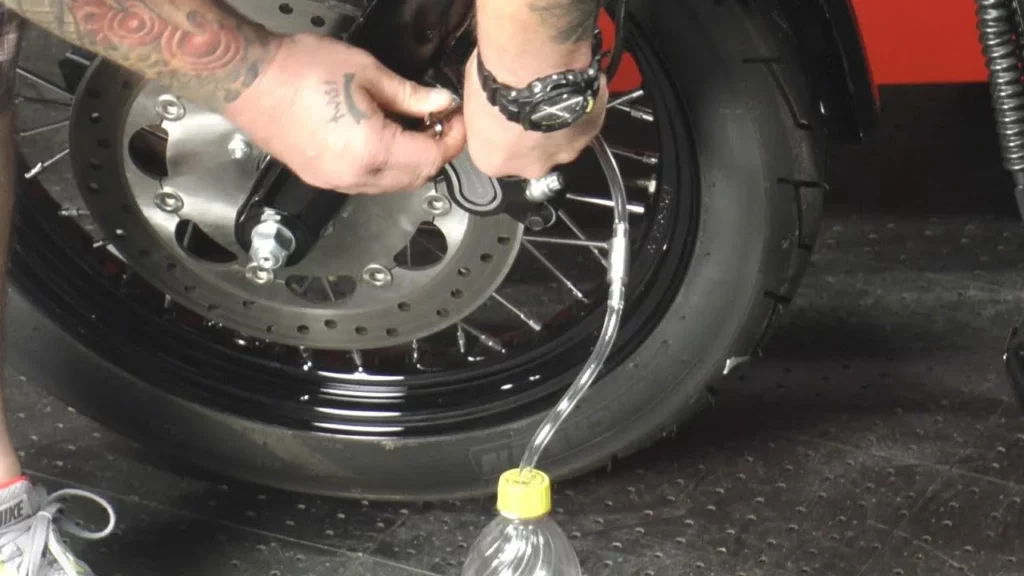Bleeding the brakes involves purging the air and replacing old fluid with fresh fluid, ensuring a firm and responsive brake pedal or lever. Whether you’re experiencing spongy brakes, performing brake system repairs, or simply conducting routine maintenance, learning how to bleed your motorcycle brakes is a valuable skill for any rider. In this guide, we will take you through the step-by-step process of bleeding your motorcycle brakes effectively and safely.

Here’s a step-by-step guide on how to bleed motorcycle brakes:
Start by ensuring that your motorcycle is on a level surface and the engine is turned off. Place the container under the brake caliper to catch the old brake fluid.
Locate the brake bleeder valve on the caliper. It is usually a small valve with a rubber cap. If you have multiple calipers, start with the one farthest from the brake master cylinder (usually the rear brake).
Remove the rubber cap from the brake bleeder valve and attach one end of the clear plastic tube securely over the valve.
Place the other end of the plastic tube into the container to collect the brake fluid.
Have your friend slowly pump the brake lever repeatedly until it becomes firm. Tell them to hold the brake lever in the pressed position.
While the brake lever is held down, use the wrench or spanner to slowly open the bleeder valve by turning it counterclockwise. You should see brake fluid and air bubbles flowing through the plastic tube into the container. Maintain gentle pressure on the brake lever.
Once the fluid flow slows down and there are no more air bubbles in the tube, close the bleeder valve by turning it clockwise. Make sure not to release the brake lever until the valve is fully closed.
Repeat steps 5 to 7 until you see clean brake fluid flowing through the tube without any air bubbles. This indicates that the air has been purged from the brake system.
Move on to the next caliper and repeat the process, starting from step 3. Continue bleeding the brakes in the order specified by your motorcycle’s manual until all calipers are done.
Check the brake fluid level in the master cylinder and top it up if necessary, making sure not to introduce air into the system.
Once you have finished bleeding all the calipers, replace the rubber caps on the bleeder valves and ensure they are securely in place.
Double-check the brake lever’s firmness. If it feels spongy or soft, repeat the bleeding process to ensure all air is removed.
Why Would You Need to Bleed Motorcycle Brakes?
Over time, air can get trapped in the brake lines, which can cause a spongy or unresponsive brake feel. Bleeding the brakes removes the air and ensures proper brake performance.
Brake fluid can become contaminated with moisture or debris over time, which can affect its performance. Bleeding the brakes replaces the old fluid with fresh fluid, improving braking efficiency.
Bleeding the brakes is part of routine brake system maintenance. It helps keep the brake system in good working condition and ensures optimal performance and safety.
If you have recently replaced brake components, such as the brake calipers, brake lines, or master cylinder, bleeding the brakes is necessary to remove any air introduced during the repair or modification process.
If you notice that your brake pedal or lever feels soft, spongy, or has excessive travel, it could be an indication of air or moisture in the brake lines. Bleeding the brakes can help resolve this issue and restore a firm and responsive brake pedal/lever.
It’s important to bleed the motorcycle brakes whenever necessary to maintain optimal braking performance and ensure your safety on the road. If you’re unsure about performing this task yourself, it’s advisable to consult a professional motorcycle mechanic for assistance.
Conclusion:
Bleeding your motorcycle brakes is a crucial maintenance task that should not be overlooked. By following the step-by-step process outlined in this guide, you can ensure that your brake system operates at its best, providing you with reliable stopping power and enhancing your safety on the road.
Regularly bleeding your motorcycle brakes removes air bubbles and eliminates contaminated brake fluid, which can compromise braking performance. It’s important to pay attention to any signs of spongy brakes or a soft brake lever and address them promptly by bleeding the brakes if necessary.
Remember, if you’re unsure about performing the task yourself, it’s always wise to seek the assistance of a professional motorcycle mechanic. They have the expertise and specialized tools to carry out the brake bleeding process accurately.
By taking the time to properly bleed your motorcycle brakes, you’re taking an active step towards maintaining your motorcycle’s performance and ensuring your own safety. Stay vigilant, follow the recommended maintenance schedule, and enjoy the peace of mind that comes with having a well-functioning braking system.

